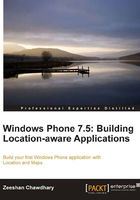
Understanding location-based services
The concept of location-based services refers to services that integrate a mobile device's location with other topical information, to provide additional value to users. Consider a weather app that shows weather information for all of the United States of America cities. For a user living in San Francisco, this behemoth of information is not very helpful unless he can see the exact weather information for his city. This is achieved by mashing up the weather information with the user's location (generally obtained using a GPS system).
Another example of LBS is local search websites such as CitySeekr.com that presents a user with hyperlocal (read local, nearby, or neighborhood-centered) information about hotels, restaurants, shopping and entertainment venues that makes the user feel connected with the type of information shown to him/her. Still another example is the integrated Bing search in your Windows Phone 7.5 based phone (Nokia Lumia 800 in our case), which fetches the search request for hotels in san francisco with the location angle as well as regular web and image search, as shown in the following screenshot:

The core requirement for LBS is GPS (this will be covered in more detail shortly), a space-based satellite navigation system developed and maintained by the United States of America. Other countries also have similar systems; Russia has the Russian Global Navigation Satellite System (GLONASS) and Europe has the Galileo positioning system. India and China are working on their own positioning system as well, but GPS remains the most popular and preferred choice for device makers and application developers worldwide.
Anyone can use GPS freely by using either a Personal Navigation Device (Garmin, TomTom), an in-car navigation system (Ford SYNC), or using a smartphone.
On the mobile front, LBS also uses Bing, Google Maps, and other cartographic API services extensively (even in cases where the device does not support GPS). This is done using rich map data and geocoding services. Using geocoding and smart algorithms, a user's position can be guessed or approximated. Mobile operating systems such as Windows Phone 7.5 further the cause of LBS by integrating location into the core OS, where the location can be fetched, used, and updated by all applications.
Microsoft Windows Phone 7.5 (code name Mango) supports a Location Service Architecture that can obtain location data from the cellular network, Assisted GPS (A-GPS) that uses the network's data connection in case of weak GPS signals, as well as Microsoft's own Wi-Fi location database providing developers with a plethora of location tools and APIs to work with.
In short, LBS can be described as a combination of two services: location providers and location consumers, with GPS, A-GPS, and Windows Phone 7.5 Location API as the location providers, and GPS receivers, Windows Phone 7.5 devices, and websites as the consumers of location data.